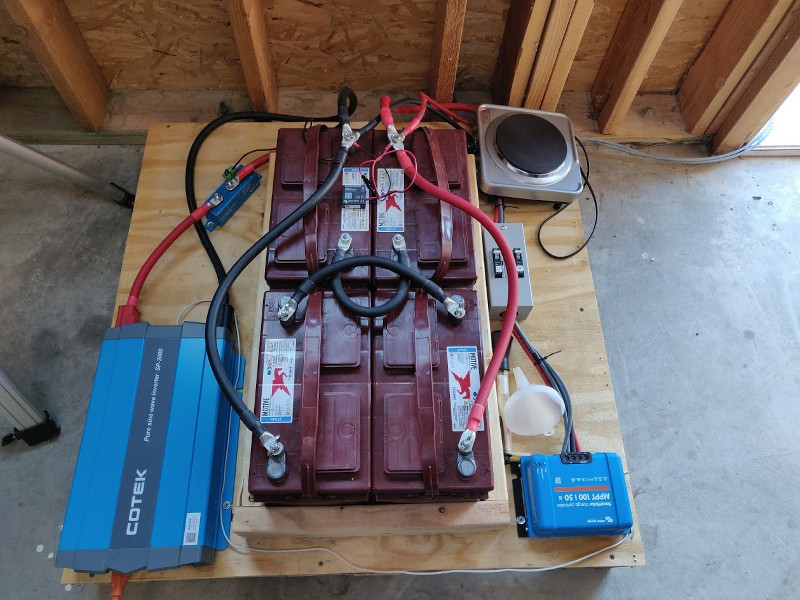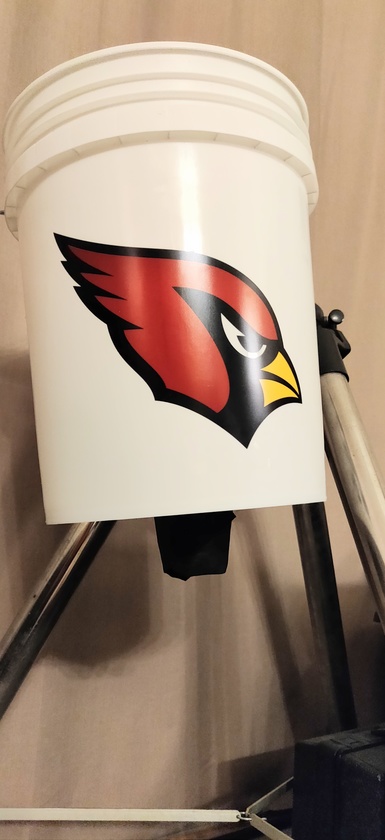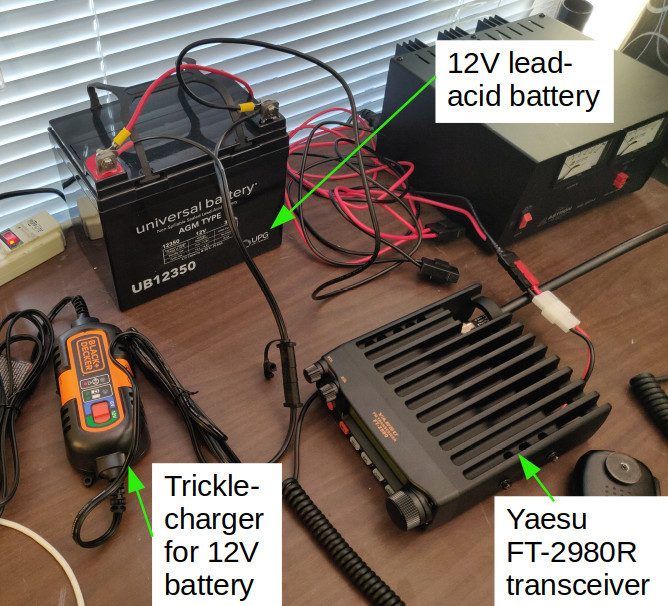The cost and technical difficulty of a solar power system varies significantly depending on what you want to be able to do. Starting with the easiest and most basic, here are some options I've come up with:
.
.
.
Level 1 Goal: Maintain basic ability to communicate locally
21 W Kit:
- 1 Standalone solar usb charger, $70: https://www.amazon.com/Anker-Charger-PowerPort-iPhone-Galaxy/dp/B012YUJJM8/
- 1 USB battery, if you don't already have one, $20: https://www.amazon.com/Anker-PowerCore-Ultra-Compact-High-Speed-Technology/dp/B0194WDVHI/
- 1 USB charger cable for UV-5R radios, $12: https://www.amazon.com/BTECH-Charger-9-10-8V-Transformer-compatible/dp/B01H2HN1KO/
Total: $111
This allows you to charge up your phone and UV-5R handheld radio. Charge the radio through the battery, not directly from the panel. This should be considered the bare minimum for your backup power because without it you will lose your ability to communicate once your batteries are drained.
From my testing I've found that the panel charges a 22.2 W-h USB battery over about 5 hours through a window with mostly direct sun (the one I linked is a larger battery and would probably take more like 8 hours). That USB battery then charges 2 bars of battery for the UV-5R over about 2.5 hours. Getting direct sunlight on the panels (instead of through a window) basically doubles the current, by the way, but I haven't had a good opportunity to leave it outside unattended.
.
.
.
Level 2 Goal: Limited power for small devices
100 to 200 W Kit:
- Panel / PWM Charge controller, $161: https://www.amazon.com/Renogy-Monocrystalline-Negative-Controller-Connectors/dp/B00BFCNFRM
- Battery, $160: https://usabatterysales.com/pd-trojan-27-tmx-115ah-deep-cycle-battery-free-delivery-most-locations-in-the-lower-48.cfm
- Tiny inverter, $30: https://www.amazon.com/BESTEK-300W-Power-Inverter-Adapter/dp/B004MDXS0U
- Attaching inverter to battery, $6: https://www.amazon.com/SMAKN-Cigarette-Lighter-Connector-Adapter/dp/B074CT5CSN/
- Battery monitoring device, $17: https://www.amazon.com/DROK-Programmable-Temperature-Percentage-Indicator/dp/B07759SLYP/
- Optional USB power converter (for slightly better efficiency), $21: https://www.amazon.com/BESTEK-150W-Power-Inverter-Car/dp/B07DW1PSRH/
- Optional additional panel, $100: https://www.amazon.com/Renogy-Monocrystalline-Solar-Compact-Design/dp/B07GF5JY35/
Total: $374 to $495
Because power generation is so limited here you won't be able to run much for very long. It's intended to charge devices and power tools, as well as a mobile radio transceiver if you have one. Adding the other 100W panel will let you use those devices for more time each day, but you will still need to be sparing and strategic with your energy use. You also need to manually monitor the battery voltage and avoid going too low, because otherwise you'll damage the cells and reduce its lifespan.
Note 1: I have not built this myself so I can't vouch for it.
Note 2: You'll need to crimp some ring terminals onto wires to make this work. I can help with that if needed.
.
.
.
Level 3 Goal: Keep the freezer running, probably...
To run a typical freezer you need about 80W x 24 H = 1920 W-h, but the freezer needs a higher current when the compressor starts up. Your inverter has to be able to handle ~600W instantaneous current, or ~5 Amps. Panels receive power for 8 - 12 hours a day, but the freezer runs whenever it needs to. It's not absolutely necessary for the freezer to always have power because your food will remain cold for hours while the freezer is off if the doors stay shut. Ideally you would have enough battery power for it to run overnight, but to save money you could skimp on this.
.
.
Here's an option for those who want something that's useful for emergencies and also for camping trips, etc. Expensive for limited power generation, but will likely be able to keep the fridge cool if you're running nothing else off of it. That 200W is very close to the lower limit for power though, so you would have to be careful to limit the time you have the fridge open. I have not built this one either, but it does generally have good reviews.
(After I spec'd this out, I see that the parts are now mostly unavailable. I'll leave it here for reference and in case parts like this become available again.)
200 W Kit:
Panel, $500: https://www.goalzero.com/shop/solar-panels/boulder-200-solar-panel-briefcase/
Charge Controller / Battery / Inverter, $1,200: https://www.goalzero.com/shop/power-stations/goal-zero-yeti-1000-lithium-portable-power-station/
Panel cable, $60: https://www.goalzero.com/shop/accessories/app-30ft-extension-cable/
Total: $1,760
.
.
I attempted to spec out a bargain basement build from the cheap parts you can find on Amazon to produce ~300W and be capable of powering a refrigerator, but there are a ton of options at this power level and it's hard to tell what's quality and what's garbage. If you're interested in going this route I will help however I can, but I don't have something I feel I can recommend.
.
.
.
Level 4 Goal: More Power!
650 W Kit:
Panels x2, $422 + $150 shipping: https://www.solar-electric.com/rec-solar-rec325np-monocrystalline-panel.html
Charge Controller, $324: https://www.solar-electric.com/victron-energy-smartsolar-mppt-100-50-charge-controller.html
Batteries x2, $320: https://usabatterysales.com/pd-trojan-27-tmx-115ah-deep-cycle-battery-free-delivery-most-locations-in-the-lower-48.cfm
Voltage Monitor, $39: https://www.solar-electric.com/victron-energy-smart-battery-sense.html
Battery Protector, $78: https://www.solar-electric.com/victron-energy-smart-batteryprotect-12-24v-100a.html
Inverter, $629: https://www.solar-electric.com/cotek-sp2000-124-2000-watt-24-volt-pure-sine-wave-inverter.html
Panel Cable, $46: https://www.solar-electric.com/mc4-extender-cable-1000-volts-50-feet.html
Other cables, ~$100: https://www.batterycablesusa.com/1-0-gauge-battery-cables-0-awg.html
(See attached image for list of cables)
Breakers and box:
- $33: https://www.solar-electric.com/baby-box.html
- $15: https://www.solar-electric.com/midnite-solar-mnepv-15-amps-circuit-breaker.html
- $15: https://www.solar-electric.com/midnite-solar-mnepv-50-amps-circuit-breaker.html
- $89: https://www.solar-electric.com/mnedc175.html
Total: $2,260
This is what I ended up building. You have plenty of power generation and a real charge controller to efficiently capture it. That charge controller can also handle up to 4 panels if you want to expand it. What you don't have much of still is storage capacity, but that's okay if you're careful. The freezer will still likely shut off at night, at least in the summer when it's working harder, but by being careful your food will be fine. I ultimately bought another pair of batteries (+ $320) just to make it more versatile.
During the day, and preferably after the batteries are recharged, you'll have plenty of power for charging devices, powering radios, and running higher current tools like a circular saw or stick welder for brief periods of time. Most importantly for me, your can also run a microwave. That means boiling water efficiently for freeze dried meals without having to make fires, and it's also very convenient for preparing other food.
You can get cheaper versions of each of these components, maybe. From what I saw, I wasn't saving that much money in the end and I felt that the additional certainty of using quality parts was worth the extra price. Also, Northern Arizona Wind and Sun often has sales and I bought when it was %10 off. That savings was largely offset by shipping fees, so I think I paid $2,357 total including the 2nd set of batteries.
Long term, I was planning to install this system on a travel trailer, but for now it's just set up on the ground with some wood frames propping the panels up. It has been running a freezer for several months without any issues, and I've also tested a microwave, fan, hotplate, and circular saw.
[I'm reposting this to the top because we have a number of people who still need to get their ham license!]
For anyone near Tucson who hasn't already gotten your Ham license or is interested in upgrading what you already have, here is some info based on my experience of getting my Technician and General licenses recently:
- Free testing is available monthly in Tucson. Next event is March 8th @ 7PM . https://k7rst.org/testing.html
-- There is no preregistering. You just show up, but I highly recommend being there a half hour early to get in line. I was there 15 minutes early and waited a little more than an hour before it was my turn to take the test, and then there's more waiting in between exams if you take more than one.
- There is also an online testing option available now. It generally costs ~$15 and you need fairly decent internet, a computer with a webcam, and a phone with a camera. (Thanks to @freebirdie for sending me the info on this).
-- Look here to find a session that's open: ...
I've been meaning to document this for quite awhile but things kept getting in the way. I've been writing this slowly over the past several weeks now, and am finally ready to post it!
I've created a simple automated planter for low-effort food gardening that seems to work pretty well for a a decent number of different plants. This was originally inspired by Larry Hall's "Rain Gutter Grow System", and then I fused it with the general concept of bottom-watered reservoir planters, which you can find everywhere.
Larry Hall's video should show up at the end of this post:
One implementation of a standard, non-automatic, bottom-watered reservoir planter:
https://www.amazon.com/GroBucket-Watering-sub-irrigated-Container-portable/dp/B079CT29RZ/
My goals were to keep costs relatively low, minimize water usage, and minimize the weekly time I need to put in to maintain the garden. I don't mind spending a bit more time to get something set up if that means I don't have to remember to do another ...
I've recently upgraded my VHF transceiver capability, and it has made a huge difference. We ask everyone to have a radio of some sort, and the cheapest Ham radio that works is the Baofeng UV-5R. I don't want to ask people to spend a ton of money, but from my own experience I do think upgrading is worth the extra expense. The receive electronics on the UV-5R are low-quality so they don't seem to work well with external antennas. A lot (or all) of the advantage you'd get from putting an external antenna up on your roof is lost when you plug it into the UV-5R.
The tranceiver I bought is the Yaesu FT-2980R:
https://www.hamradio.com/detail.cfm?pid=H0-015771
Unfortunately they just raised the price by $20, but it's still only $150 (or closer to $170 with shipping and tax). Note that it's a VHF only radio and is very simple compared to the more expensive models, but it is a beast of a machine that can dump 80W of power if needed.
This radio works well with every external antenna I've tried, and it's well suited to ...



























